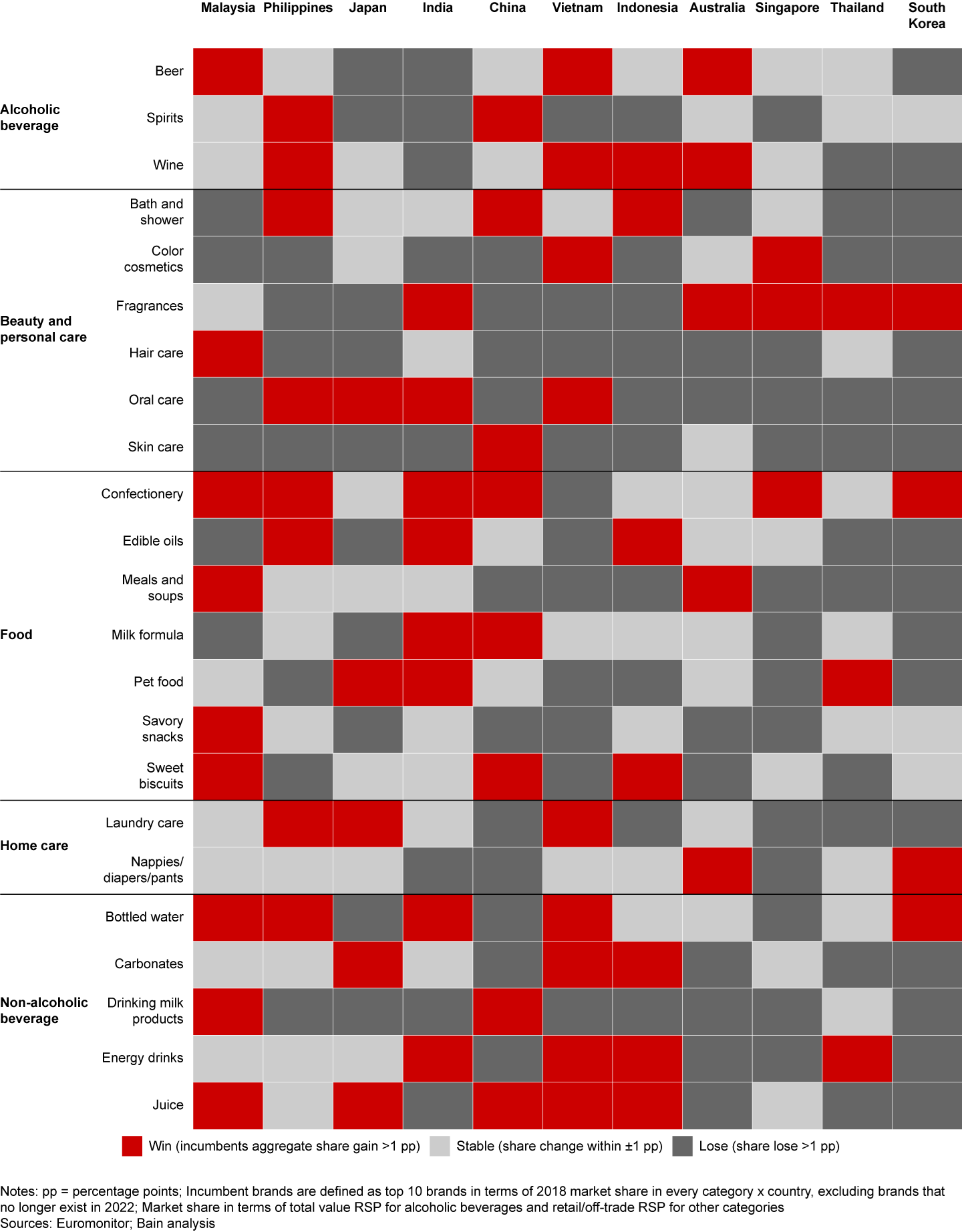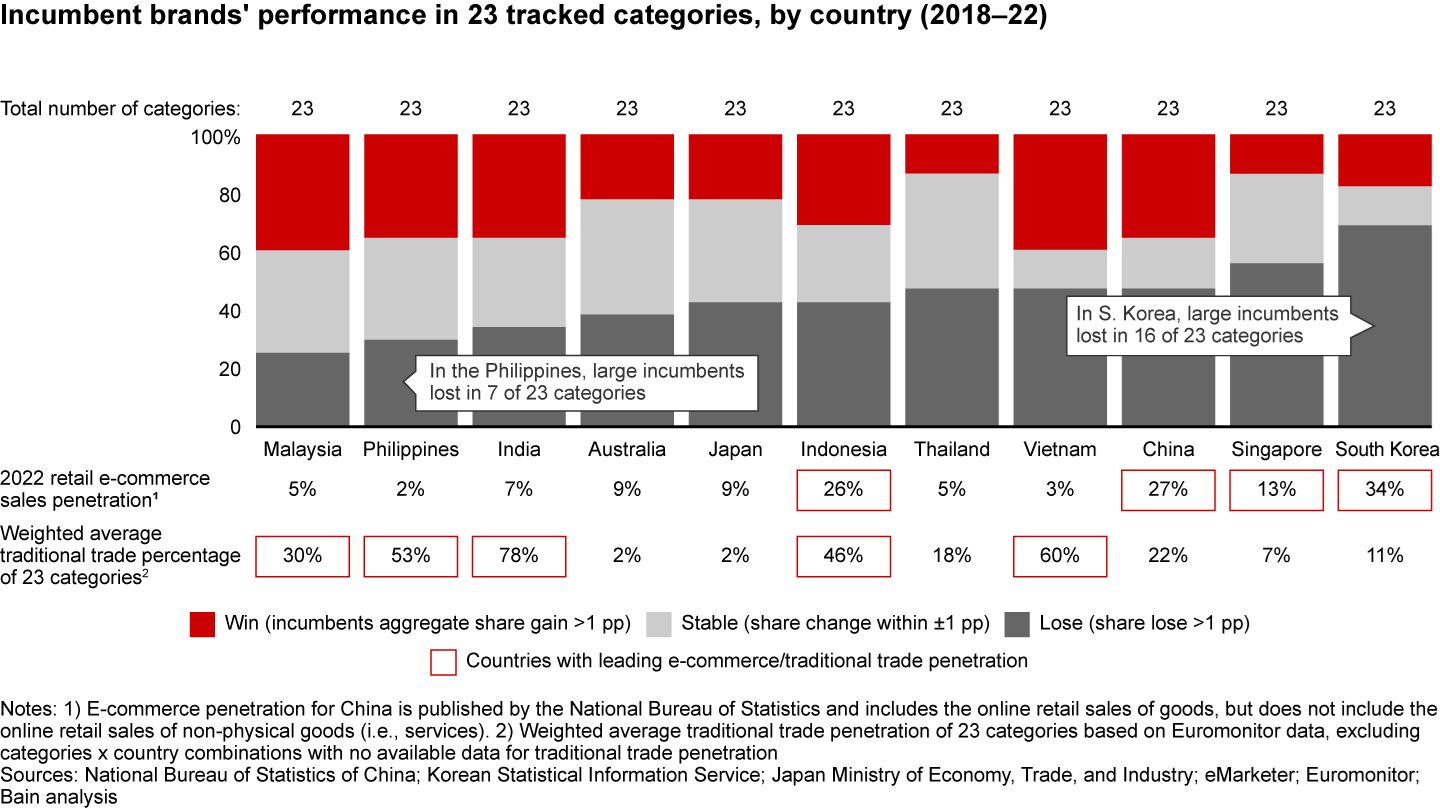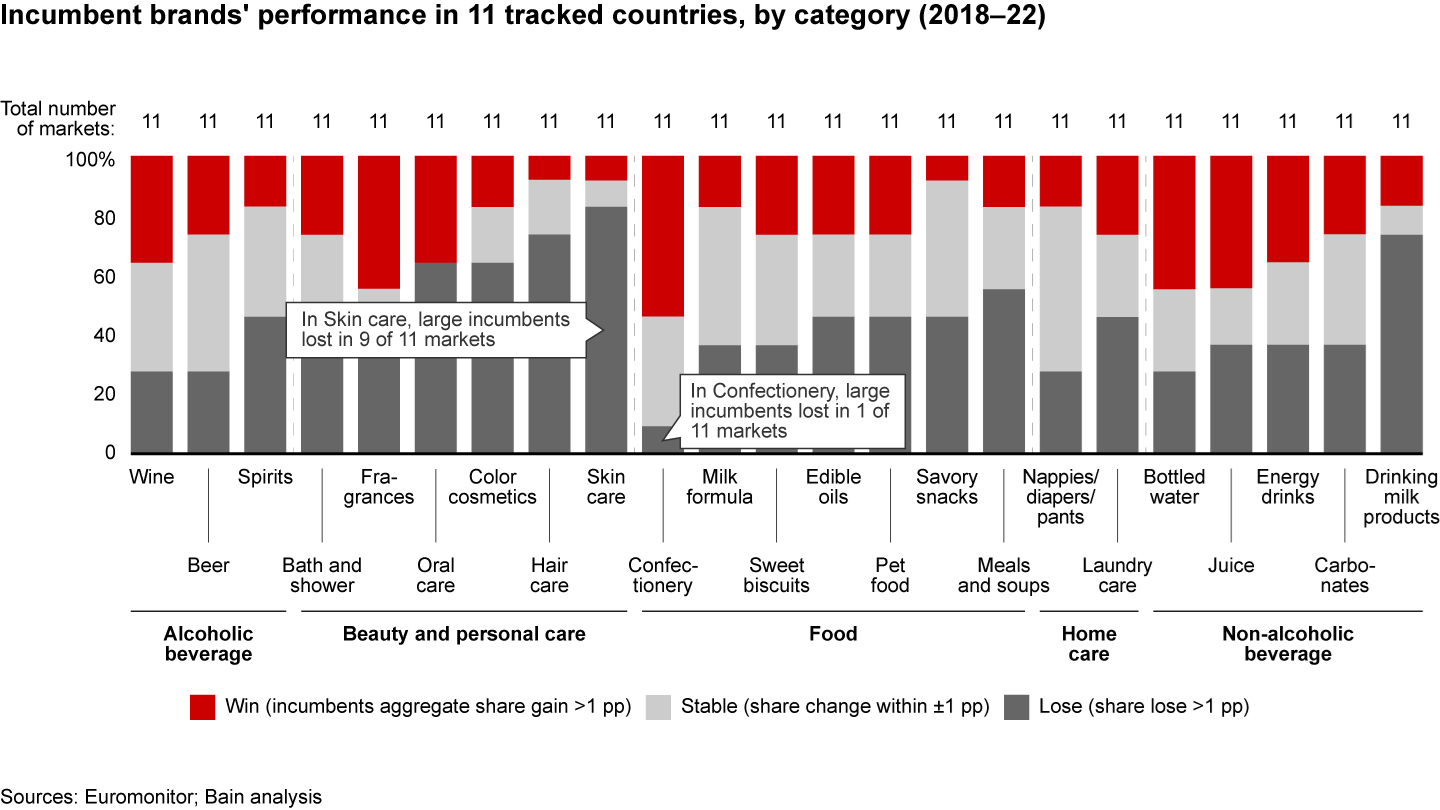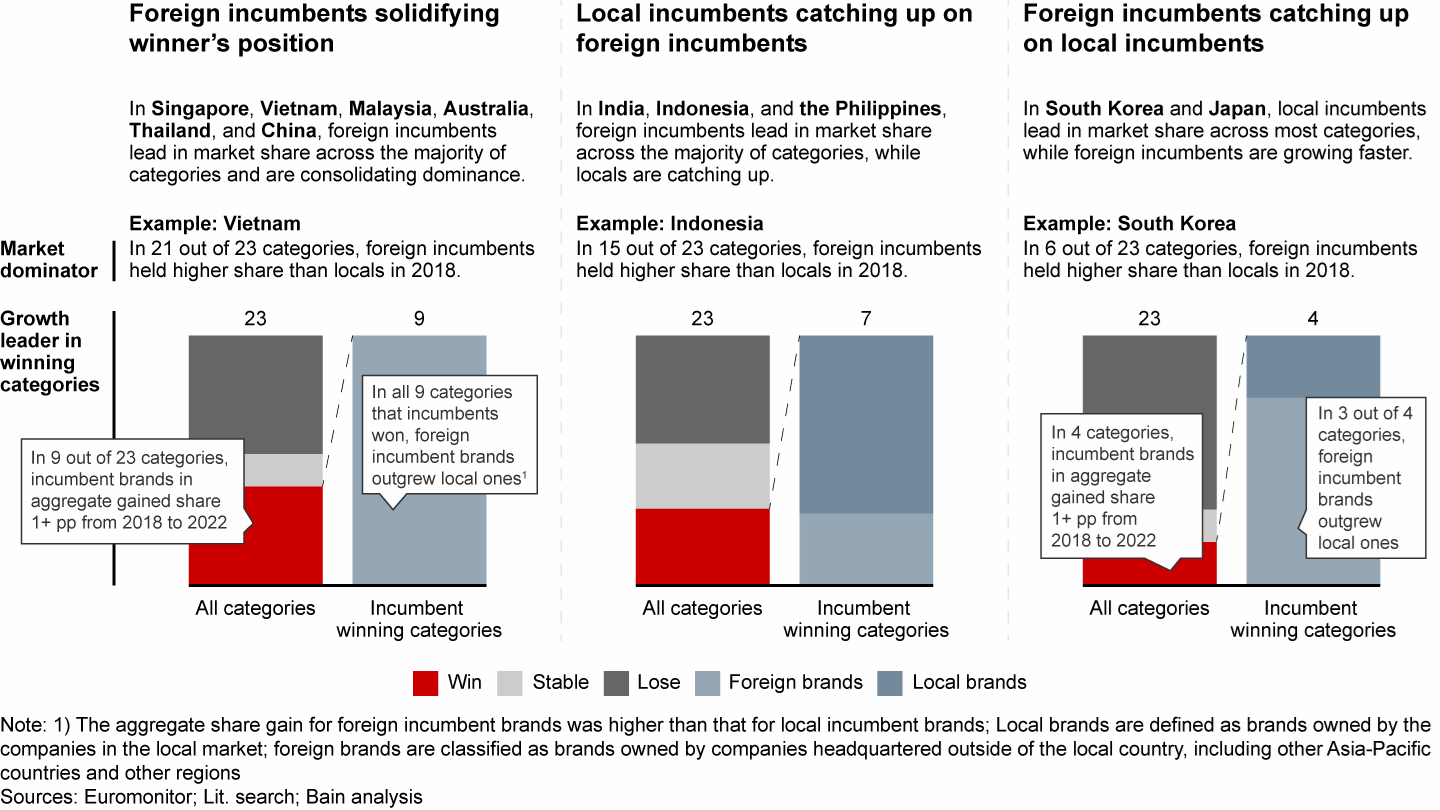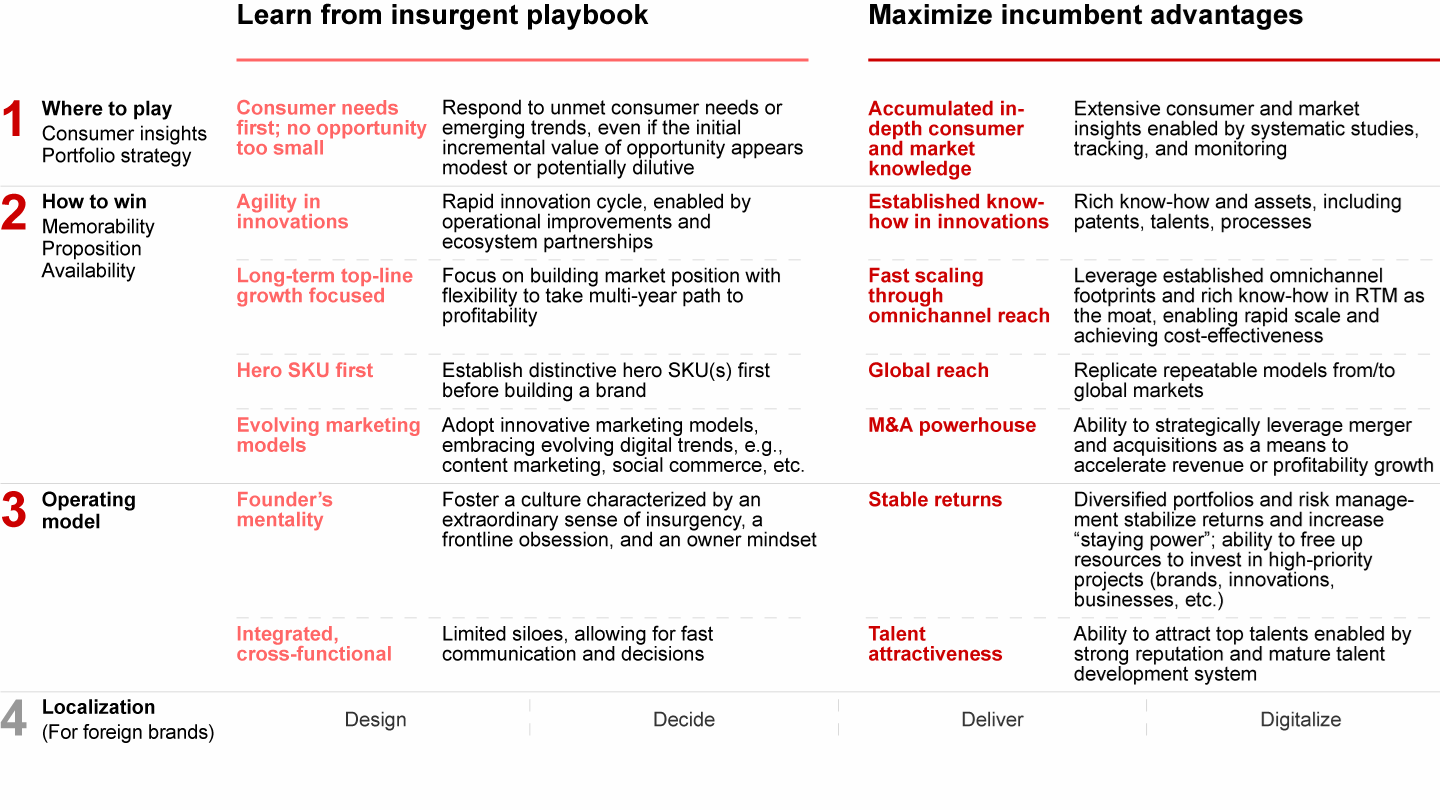Brief

At a Glance
- Our analysis of 23 consumer product goods categories in 11 Asia-Pacific markets from 2018 to 2022 shows that while insurgents have made significant inroads, many incumbents have maintained or even increased their market share.
- No single category or market factor explains the success or failure of incumbent brands. Channel dynamics seem to be more influential than category characteristics. But what matters most is how incumbents manage their categories and brands.
- Successful incumbents blend their inherent strengths with insurgent strategies, leveraging scale while embracing agility and innovation.
The rise and reinvention of established Asia-Pacific CPG brands amid insurgent threats
We have all heard the narrative—insurgent brands are on the rise while large incumbent brands face an increasingly gloomy future due to falling barriers to entry and thriving innovation. However, Bain data analysis across 23 consumer product goods (CPG) categories in 11 Asia-Pacific markets from 2018 to 2022 reveals a more nuanced reality.
While insurgent brands have made inroads in capturing market share from established brands, this trend is not all-encompassing. Despite the genuine threat posed by these emerging brands, many established brands continue to achieve success. With strategies specifically tailored to their strengths and market dynamics, incumbents can thrive even amid the growing presence of insurgents.
We studied 253 category and market combinations in Asia-Pacific over five years. We found that while large incumbent brands lost in 112 cases (defined as losing more than 1 percentage point of market share in aggregate), incumbents held steady in 72 cases and won (gained more than 1 percentage point of market share in aggregate) in 69 cases. There was no single category where incumbents lost share across every Asia-Pacific market, nor a single market where they lost share across all categories (see Figure 1). So, while insurgents have gained ground in more situations than incumbents have gained, the results show significant variation depending on the specific market and category.

Channel dynamics seem to be more influential than category characteristics
Our analysis of 11 Asia-Pacific markets shows a varied competition pattern between incumbents and insurgents (see Figure 2). Notably, South Korea, Singapore, and China emerge as the most favorable environments for new entrants. This trend could be linked to their thriving e-commerce sector and well-established networks of third-party suppliers, making these regions particularly conducive for insurgent growth.
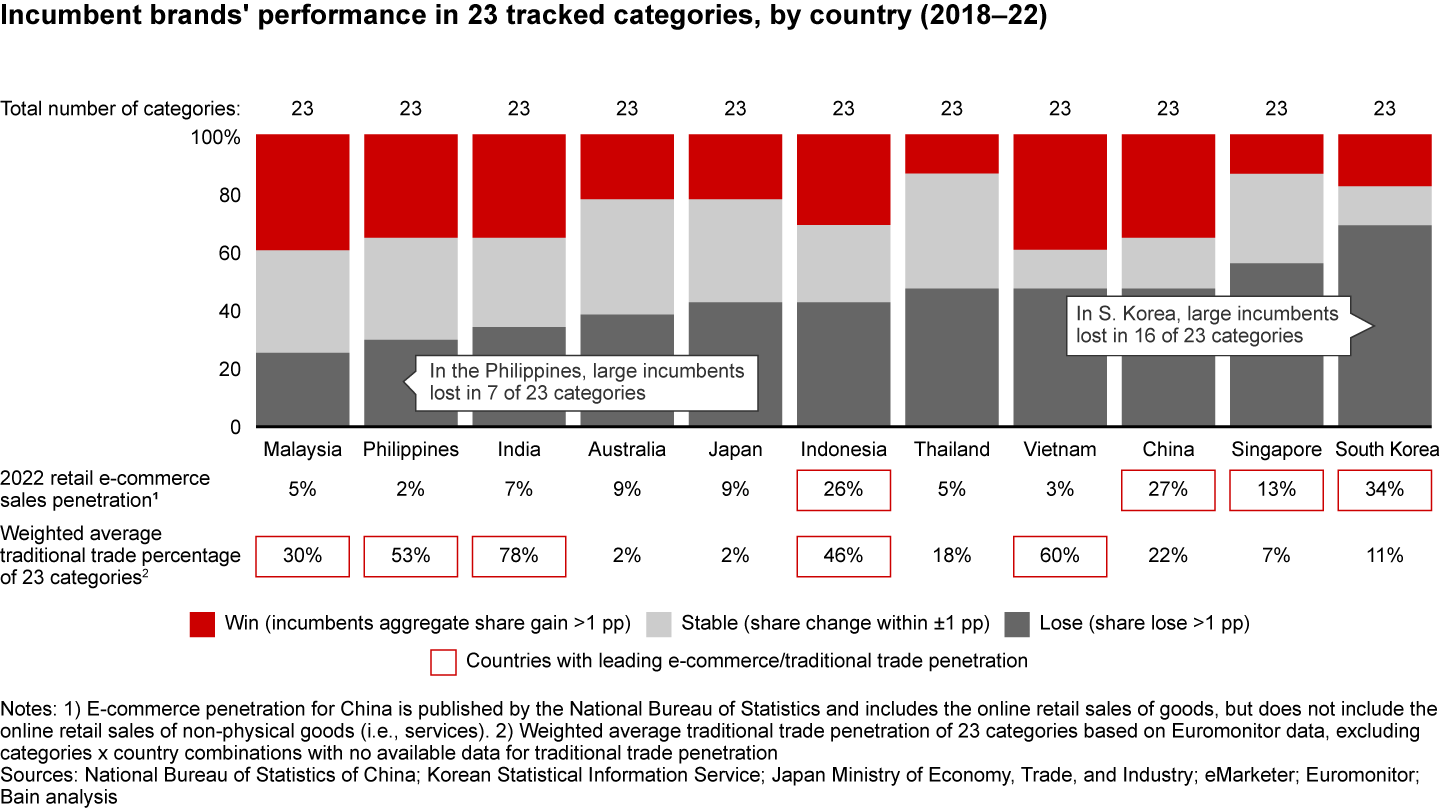
South Korea, for example, stands out as one of the leaders in the Asia-Pacific region for e-commerce development. The country witnessed an impressive e-commerce sales penetration of approximately 34% in 2022. This market is also distinguished by its robust infrastructure of third-party suppliers, to which small brands can outsource elements of their value chain. Such an ecosystem significantly reduces the barriers to entry for new businesses, intensifying the competitive pressure on established companies. This heightened competition is reflected in large incumbents losing ground in 16 of the 23 monitored categories.
In contrast, Malaysia, the Philippines, and India are the most favorable markets for incumbents. This trend can be attributed to the dominance of traditional trade, especially in the Philippines and India, and the relatively low penetration of e-commerce. The complex channel dynamics in these markets create a challenging environment for new entrants.
For instance, traditional trade accounts for approximately 53% of the retail value across the 23 categories analyzed in the Philippines. This significant share underscores the importance of robust route-to-market (RTM) capability for brands aiming to succeed in the market. Such a landscape presents a formidable barrier to entry for new competitors. This is reflected in the fact that large, established incumbents only lost in 7 of the 23 categories, indicating their continued dominance in a market where traditional channels still play a pivotal role.
Category-by-category, our analysis revealed a spectrum of outcomes. Overall, the beauty and personal care sector emerged as the most receptive to insurgent brands, in stark contrast to other sectors, including alcoholic and non-alcoholic beverages, food, and home care. Within the beauty and personal care category, hair care and skin care were particularly insurgent-friendly, with established brands losing their market share in 8 and 9 of the 11 markets, respectively. On the opposite end, the confectionery category proved to be the stronghold for incumbent brands, as incumbents only lost in 1 of the 11 markets within this category (see Figure 3).

Delving into the performance of large incumbents based on their origins, three distinct patterns emerge (see Figure 4). In most Asia-Pacific countries, such as Australia, Singapore, and Vietnam, foreign incumbent brands (i.e., incumbent brands owned by overseas-headquartered companies) continue to lead in market share across the majority of the 23 tracked categories and demonstrate greater resilience by outgrowing their local peers in most winning categories.
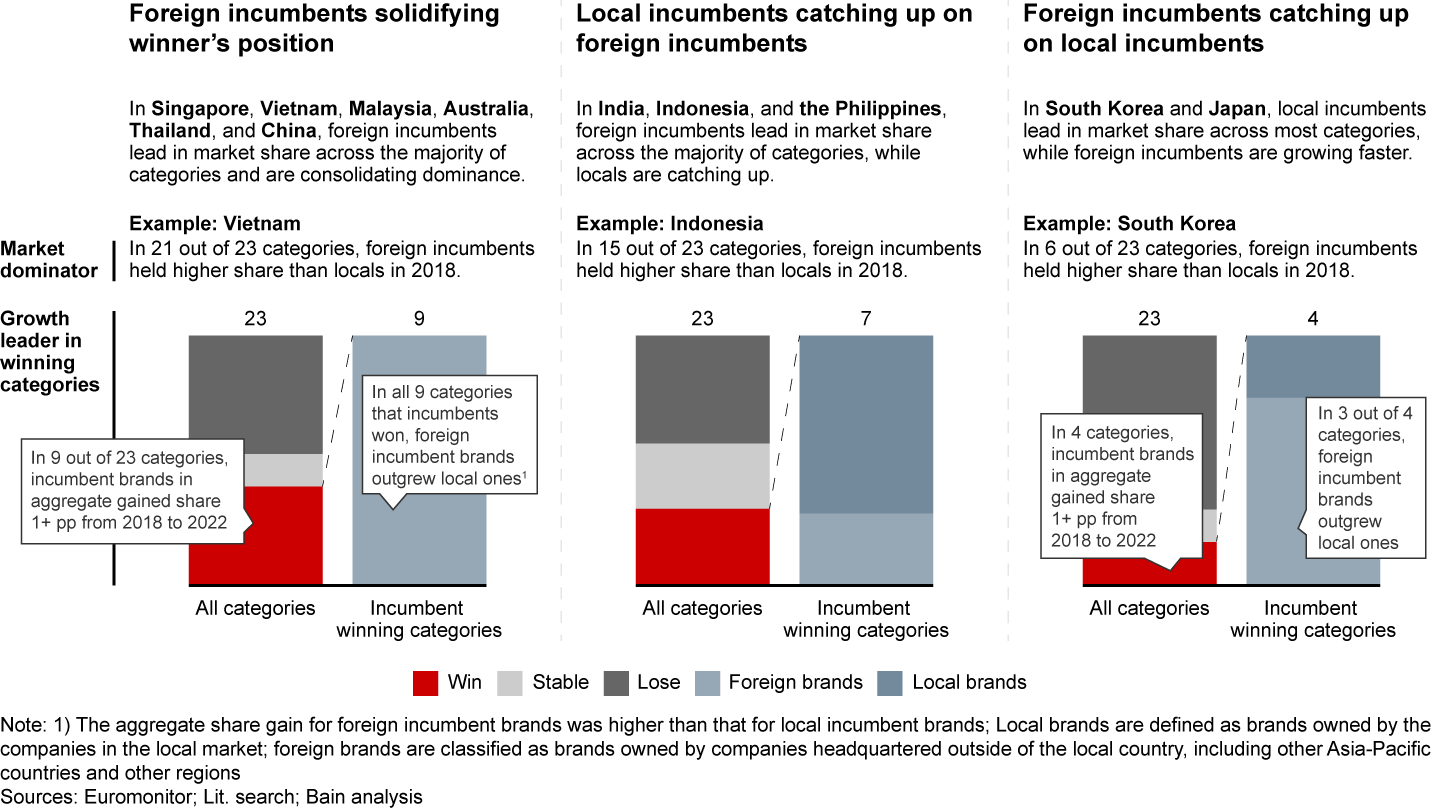
However, in India, the Philippines, and Indonesia, while foreign incumbents also lead in market share across most categories, it is the local incumbents that exhibit a stronger ability to gain share in the winning categories. For instance, foreign brands in Indonesia led 15 out of the 23 tracked categories in 2022. Nonetheless, local incumbents have shown higher growth in five of the seven incumbent-winning categories, including wine, juice, and sweet biscuits, from 2018 to 2022. The success of these local brands can be attributed to their extensive distribution networks in rural areas and lower-tier cities, where they effectively leverage traditional trade channels.
In South Korea and Japan, local brands have traditionally dominated the market. However, foreign brands have recently begun to lead growth in some incumbent-winning categories, such as carbonates in Japan and fragrance and diapers in South Korea.
Covid-19 experience was also nuanced
Another common narrative is that the Covid-19 pandemic enabled incumbent brands to regain traction as consumers sought out well-known brands during times of uncertainty. At the same time, larger manufacturers were better equipped to navigate supply chain disruptions. Again, our study showed a mixed impact among the Asia-Pacific countries. During the year of peak Covid-19 restrictions, incumbent brands experienced increased success in 7 of the 11 countries we analyzed. India and China saw the most substantial gains, where incumbents gained in eight and five additional categories, respectively, compared to the previous year. On the other hand, in countries like Malaysia, Singapore, Vietnam, and Australia, there were either no significant changes or incumbents lost in more categories during the peak periods of Covid-19 restrictions. In summary, incumbents gained traction during Covid-19 in some markets, but not in others.
Insurgents have momentum in many situations, but our data show resilient incumbent brands can hold steady or gain share across a wide range of markets and categories in Asia-Pacific. While market, category characteristics, and macro situations do contribute to incumbents’ success to some extent, what matters most is how they manage their categories and brands.
What we learned from large incumbent winners
In today’s era of swift disruption, established players can find it challenging to match the agility of emerging competitors. Our research reveals that successful incumbent companies are adept at incorporating the most effective strategies from insurgent competitors while leveraging their inherent strengths. They have harnessed their scale to their advantage. They have skillfully navigated typical pitfalls, such as complexity and inertia, which often beset large organizations. Additionally, they have shown a capacity for innovation, investment, and execution that would make even the most ambitious insurgents proud. The success of Asia-Pacific incumbent brands can be expressed in a four-part framework (see Figure 5):
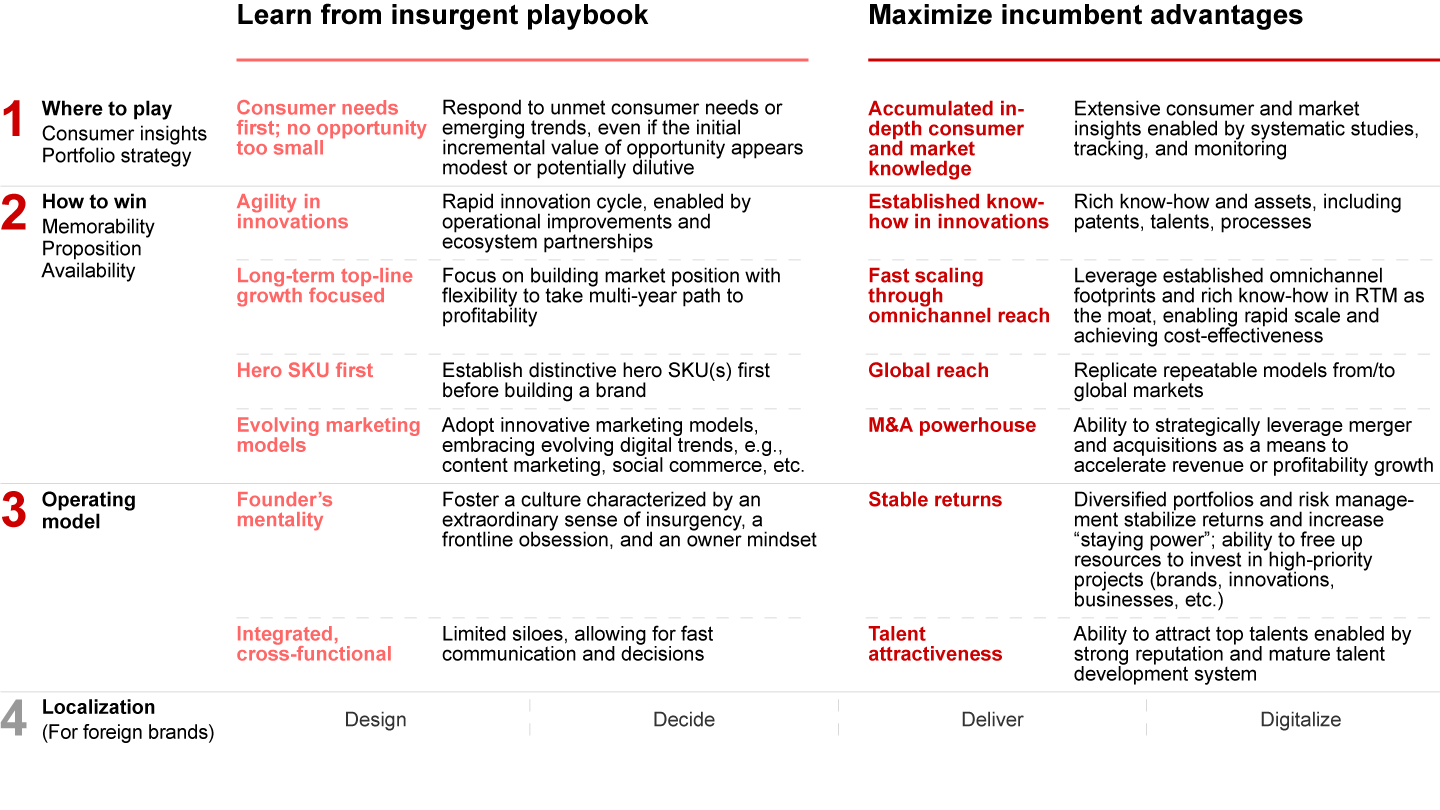
- Where to play: These incumbents establish an in-depth understanding of local consumers to identify growing demand and drive portfolio growth within and beyond the current market.
- How to win: They foster a repeatable growth model by building strong brand memorability, establishing a best-served brand proposition, and optimizing availability.
- How to operate: Successful incumbents develop differentiated capabilities that create sustainable competitive advantages.
- How to localize (for foreign brands): Successful foreign incumbents proactively localize core capabilities, enabling them to compete like local players.
Where to play
Successful incumbents capitalize on the extensive consumer and market insights gained from years of operation to identify emerging market opportunities. They are attuned to the market, searching for unmet consumer needs, and are often willing to innovate based on emerging trends, even when these new prospects initially seem minor compared to their existing business. Other successful incumbents adopt solutions that insurgents are trying to scale—solutions that resonate with consumers—and use their scale advantage to build distribution and brand awareness and achieve cost-effectiveness quickly.
By-health, a leading Chinese vitamin and dietary supplement (VDS) brand, exemplifies this strategy. In recent years, By-health has been proactive in identifying and responding to emerging consumer trends. It has strategically entered burgeoning niche sub-segments, such as eye health, liver protection, and beauty and weight management, positioning itself as one of the early movers in these areas.
The brand has forged partnerships with prestigious institutions for advanced research and development, leveraging its stature as a major player to build a competitive edge through accumulated expertise. By-health has also dramatically accelerated its innovation process, achieving a pace on par with insurgent brands. This agile approach has been instrumental in By-health’s ascent to the top position in China’s VDS market, supplanting the previous market leader. As a result of these strategies, By-health has achieved a CAGR of 15%–20% from 2018 to 2022.
Similar examples can be observed among successful incumbents in the region. Baixiang, a leading noodle brand in China, has transformed its approach to innovation by becoming consumer-centric. Embracing a “test and learn” philosophy, the brand has adapted to emerging consumer trends and scaled by leveraging its established channels, leading to the successful launch of several health-focused premium products. Meanwhile, Great Northern, the leading Australian beer brand owned by Carlton & United Breweries, can attribute its success to its deliberate positioning, which targeted its competitor’s stronghold in terms of occasions (outdoor lifestyle), taste (light profile), and geography (Queensland). Likewise, a leading food brand in India, Tata Sampann, has achieved an approximately 20% CAGR in the past five years by addressing consumer needs for high-quality, healthy, and nutritious staple foods. It was one of the first movers into the branded pulses market in India, gradually expanding into categories such as spices, poha, and dry fruits.
By leveraging their unparalleled consumer insights to expand methodically into high-potential niches, some incumbent winners have fueled tremendous growth. Their strategic playbook could provide a model for other incumbents looking to play to their strengths.
How to win
Winning incumbent brands in the Asia-Pacific markets have crafted a repeatable growth model by building strong brand memorability, establishing a well-defined brand proposition, and optimizing availability across their markets.
Our research reveals that incumbent winners adopted strategies inspired by their insurgent competitors. These strategies include focusing on long-term top-line growth, prioritizing a “hero” SKU approach, and employing a marketing strategy that follows the evolving market landscape. Simultaneously, these incumbents leverage their strengths, including fast-scaling capabilities and an established omnichannel presence. They effectively combine insurgent brands’ learnings with their established market advantages, such as global reach and M&A capabilities.
Pucuk Harum, Indonesia’s top ready-to-drink (RTD) tea brand, exemplifies this. It leverages the distribution network of its parent company, Mayora, to achieve the highest numerical distribution in the RTD tea market. The brand consistently invested above the average in advertising for years, focusing on its hero product—the regular 350 ml Pucuk Harum Jasmine. This strategic focus has helped it capture an approximately 30% share of the RTD tea category with this single SKU.
In expansion, certain incumbent victors enhance their global presence by adopting global best practices for international markets. For instance, Samyang Foods achieved a 20% CAGR in overseas revenue over the past five years. This success stems from replicating a global expansion model initially developed and proven effective in China and then applied to other international markets. Additionally, the brand has leveraged social media as the primary touchpoint to sustain a “viral” effect and maintain active engagement with consumers.
Finally, the resources and capabilities of incumbents to engage in M&A provide them with a growth advantage. For example, Amore Pacific recently acquired COSRX, an insurgent cosmetic brand. This acquisition contributes significant operating profit to Amore Pacific’s bottom line. For more M&A studies, please read “Overseas Ambition: Asia-Pacific Consumer Products Companies Use M&A to Accelerate Growth.”

Consumer-led Brand Growth
A powerful, data-driven solution that puts consumers at the heart of your growth strategy.
How to operate
Insurgents are characterized by their agility, integrated organization, and creative house culture. Our analysis suggests that successful incumbent companies and brands increasingly embrace this founder’s mentality, which can be defined by three distinct traits: an extraordinary sense of insurgency, a frontline obsession, and an owner’s mindset. Meanwhile, many incumbent winners transformed their organizations into more integrated and cross-functional entities that reduce complexity and act decisively to overcome and dismantle bureaucracy, thereby allowing them to compete more effectively in a dynamic market.
Meanwhile, incumbent winners leverage their diversified portfolios and robust risk management capabilities to maintain financial resilience amid market fluctuations. They actively manage their cost structure, redirecting financial resources when necessary to revitalize growth. For example, South Korean food and beverage company Nongshim conducted a scaled cost transformation program in recent years, nearly doubling its EBIT. This strategy provided the necessary resources to invest in high-priority projects. Moreover, the established stability, reputable standing, and well-developed talent systems of incumbent winners make them appealing to professionals. Prospective employees see large incumbents as able to provide secure and progressive career paths. This gives them an edge in the fierce competition for talent.
How to localize for foreign brands
Our research highlights that localization plays a crucial role in the success of foreign companies in the Asia-Pacific region. A prime example of this can be seen in China. Successful foreign incumbents in this intense market gain a competitive edge by employing a “4D approach”:
- Design for China by rigorously tailoring products for Chinese consumers and having local R&D.
- Decide in China by adapting the operating model for more local decision authority.
- Deliver at China speed using the ecosystem and micro-battles for rapid pace, trial and error, and fast learning.
- Digitize China operations with data-driven and algorithmic approaches, including closed-loop consumer engagement.
In China, a few foreign brands (including L’Oreal Paris, Huggies, and Budweiser) have excelled in competitive Chinese local markets with this 4D approach. Read more: “How to Behave Like a Chinese Brand”; “Consumer Products: Now’s the Time to Double Down on China.”
Conclusion
Our 2018 to 2022 analysis in the Asia-Pacific region challenges the notion that insurgent brands universally disrupt incumbents. Many incumbents have successfully maintained or grown their market share amid tight competition. Despite insurgent challenges, these incumbents thrived by blending their incumbent strengths with insurgent tactics, which allows them to counter threats and strengthen their market position effectively.
